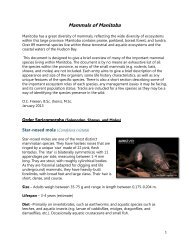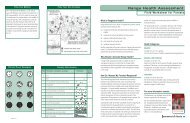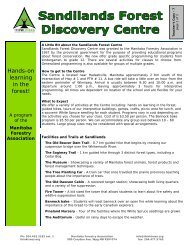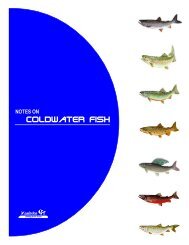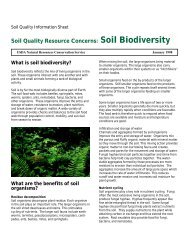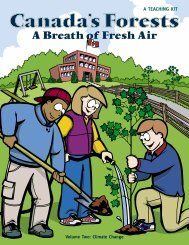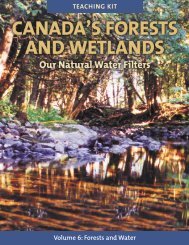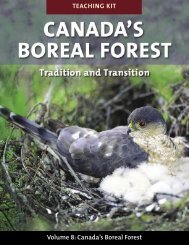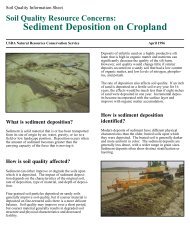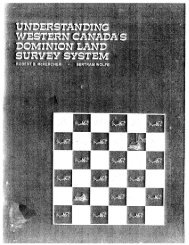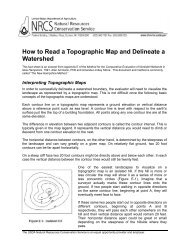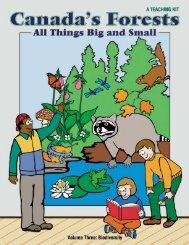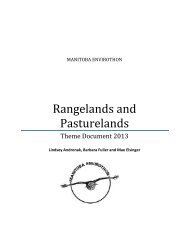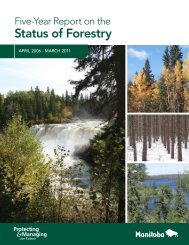TREE MEASUREMENT GUIDE - Manitoba Forestry Association
TREE MEASUREMENT GUIDE - Manitoba Forestry Association
TREE MEASUREMENT GUIDE - Manitoba Forestry Association
Create successful ePaper yourself
Turn your PDF publications into a flip-book with our unique Google optimized e-Paper software.
<strong>TREE</strong> <strong>MEASUREMENT</strong> <strong>GUIDE</strong>GETTING THE RIGHT <strong>MEASUREMENT</strong>SThe <strong>Manitoba</strong> <strong>Forestry</strong> <strong>Association</strong> is committed to helping <strong>Manitoba</strong>ns learn about the importance of trees andforests. The following tree measurement guide is just one of the resources that we have created to help you learnabout the basics of measuring a tree. Apply these simple steps to collect the information required for yourAmazing Tree Quest Nomination.Measuring your tree not only helps you determine if you have located a tree that should be nominated as anAmazing Tree Quest Tree but this process also helps you get to know your special tree in a whole new way.EQUIPMENT REQUIREDThe equipment required to measure your tree is very low tech and many of the items on this list can be foundaround your home. This is a suggested list of equipment we would encourage you to take along on your quest foryour Amazing Tree:Flexible 50 m. Measuring Tape (or a piece of string and a standard measuring tape)Meter Stick (or another straight edged stick that is the approximate length of your arm)CalculatorA pad of paper and pencilHeritage Tree Measurement GuideGuide to the Native Trees of <strong>Manitoba</strong>(http://www.gov.mb.ca/conservation/forestry/pdf/health/fieldguidefinal.pdf) or another field guide usedfor identificationGPS Unit (optional)Camera (optional, but we encourage you to take it along!)INFORMATION REQUIREDThis measurement guide will walk you through the information you will require to fill out your Amazing Treenomination form on-line at www.thinktrees.org or www.routesonthered.ca.GENERAL <strong>TREE</strong> INFORMATIONThe tree you would like to nominate is a: Single Tree Grove of Trees
INDIVIDUAL <strong>TREE</strong> DETAILThis section has been designed to try and collect as much information on your individual tree as possible. Fill inthe information the best you can. Once received, all nominations are site verified and any information gaps will becollected at this time.Details of how to collect this information can be found below.Common Name of Tree:Latin Name of Tree:Tree Circumference: Inches or CentimetresTree Diameter: Inches or CentimetresTree Height: Inches or CentimetresCrown Spread: Feet or MetersAge: Estimated or ActualPlanted By:COMMON AND LATIN NAMES OF THE NATIVE <strong>TREE</strong>S OF MANITOBAPlease refer to the Native Trees of <strong>Manitoba</strong> guide available at:http://www.gov.mb.ca/conservation/forestry/pdf/health/fieldguidefinal.pdfHOW YOU CAN MEASURE THE CIRCUMFERENCE AND DIAMETER OF A <strong>TREE</strong>These tree measurements are used to determine the overall size of the tree. The diameter of a tree is notnecessarily a good predictor of how old the tree is. For example, a white spruce growing in Southern <strong>Manitoba</strong> willhave a much larger diameter than a white spruce of the same age growing in Churchill. This is because thediameter is influenced by factors such as length of growing seasons, water availability, sunlight, etc.Tree diameter is always taken from a consistent height of 1.3 metres from the ground. This is known as theDiameter at Breast Height, or DBH. This height was chosen in order to standardize this measurement.A precise but low tech way to measure the diameter of a tree is to use a flexible measuring tape to first measurethe circumference of the trunk and then calculate the diameter. Circumference is the distance around the trunk.PAGE 2 – MANITOBA FORESTRY ASSOCIATION – <strong>TREE</strong> MEASURMENT <strong>GUIDE</strong>
1. Take a tape measure and wrap it around the trunk of the tree at the designated height of 1.3 metres (fourfeet) above ground level. If you do not have a flexible tape, not to worry, this measurement can still betaken by using a piece of string and wrapping it around the trunk of the tree, mark the spot where thestring overlaps, and measure this length with a standard measuring tape.2. Record this measurement.3. To convert the circumference you have measured to diameter, use your calculator to divide thecircumference in centimetres by pi (3.1416). This will give you the diameter of the tree. For example, atree with a circumference of 157 centimetres (20 inches) has a diameter of 50 centimetres.Diameter (cm) = Circumference of Tree (cm) Diameter (cm) = 157 cm = 50 cm3.1416 3.1416In some cases, there might be some irregularities with the tree, either on the trunk itself or the way thetree is growing that might prevent the measurement of the tree at exactly the 1.3 meter height. Below are someexamples of these irregularities and how they should be handled.<strong>TREE</strong> ON LEVELGROUND<strong>TREE</strong> ON ASLOPELEANING<strong>TREE</strong><strong>TREE</strong> FORKING ATOR ABOVE 1.3METERS<strong>TREE</strong> FORKING BELOW1.3 METERS(MEASURE THE LARGER OFTHE TWO STEMS)<strong>TREE</strong> DEFORMED AT1.3 METERSSource: Forest Measurements Field Manual – Lakehead UniversityPAGE 3 – MANITOBA FORESTRY ASSOCIATION – <strong>TREE</strong> MEASURMENT <strong>GUIDE</strong>
HOW YOU CAN MEASURE THE HEIGHT OF A <strong>TREE</strong>Since climbing the tree to measure its height, is not recommended for safetyreasons, foresters have developed several other methods that keep your feetplanted firmly on the ground! The method you will use is referred to as theStick Method, or the Eyeball Method.1. Using a straight stick (metre stick works great), grasp it in a way thatwhen you hold it up, the portion above your hand is equal to the exactlength of your arm. Hold your arm out horizontally in front of you.2. Walk away from the tree to a point where, by holding the stick vertically at arm’s length, the entire tree’svertical centerline is hidden behind the stick. The top of your stick will line up with the tip of the crownand the bottom of the stick where it meets your hand will line up with where the base of the trunk meetsthe ground. This method works best when you are at the same elevation as the base of the tree.3. Use the measuring tape provided to measure the distance between your feet and the base of the tree -this distance will be approximately the same as the tree’s height.4. Record this measurement.HOW YOU CAN MEASURE THE CROWN SPREAD OF A <strong>TREE</strong>The crown spread is measuring the average spread of the branches of the tree that make up its canopy. To takethis measurement you will need to:1. Use a measuring tape or string of suitable length and measure the widest part of the crown of the treefrom periphery to periphery.2. Record this measurement.3. Repeat this procedure for the narrowest part of the crown.4. The average of these two measurements will be the crown spread of the tree.Crown spread = Narrowest Part of Crown (AB) + Widest part of crown (CD)2Source - http://www.americanforests.org/resources/bigtrees/measure.phpPAGE 4 – MANITOBA FORESTRY ASSOCIATION – <strong>TREE</strong> MEASURMENT <strong>GUIDE</strong>
HOW YOU CAN DETERMINE THE AGE OF A <strong>TREE</strong>In order to get a good estimate of the age of the tree, a specialized toolcalled an increment borer is used to extract a small core of wood fromthe tree allowing a view of its growth rings. Each year trees put on oneannual growth ring, comprised of one light band of wood early in theseason (earlywood) and one dark band late in the season (latewood).The age of the tree can be estimated by counting each pair of light anddark rings as one year.In many cases, you will not access to an increment borer, so not toworry, there are other ways of trying to determine the age of yourHeritage Tree.RESEARCH: You can do a little tree investigation work to determine the age of the tree. If the tree is located onprivate property you could contact the owner of the property to enquire about when the tree was planted, if thetree is located on municipal property the Town/R.M. office may have records of when the tree was planted, if thetree is located in a prominent location (such as in front of a historic building) there may be photographs availableat the local library that could help narrow down a time frame of when the tree was planted.You could also challenge yourself to think of other ways to estimate the age of the tree. Are there any tree stumpsnearby where the rings on the tree could be counted???<strong>TREE</strong> PLANTED BY:In some cases the tree you will be nominating might have been planted by a member of your community in thepast. The tree might be located in a front or back yard or part of a community park. If know the individual orgroup who planted this tree, please provide this information on the nomination form. If you do not know thisinformation or if the tree is growing naturally in its environment, you do not have to fill in this section.<strong>TREE</strong> LOCATION INFORMATIONAs mentioned above, your Amazing Tree could be located in a variety of locations such as a front or back yard, onthe boulevard, or in a park. Please provide the best directions you can in this section of the nomination form soothers can find and visit your Amazing Tree!The tree being nominated is located on/or is a part of a: Yardsite Boulevard Park Arboretum Shelterbelt Riverbank Road AllowancePAGE 5 – MANITOBA FORESTRY ASSOCIATION – <strong>TREE</strong> MEASURMENT <strong>GUIDE</strong>
2. Next, press the page button (the top button on the right hand side of the unit), this will take you to themain menu page. On this page there will be a list of icons for you to choose from. Please use the rocker,(the toggle button on the very front of the unit), to scroll down the page and highlight the Mark icon.PAGE 7 – MANITOBA FORESTRY ASSOCIATION – <strong>TREE</strong> MEASURMENT <strong>GUIDE</strong>
3. Press the rocker button again; this will take you to the Mark Waypoint Page. On this page you are able torecord the location of your tree. If you are interested in marking your tree as a wayward point for othersto find later please follow these steps.a. Press the rocker button, so as to highlight the default three-digit name located at the very top ofthe screen. You will have the option of saving the default name given to this point by selectingOK, or you many change the information in this field by pressing the rocker button one moretime to open the on-screen keypad. After changing the name of the location, confirm yourchanges by selecting OK.4. For you Amazing Tree Quest nomination, you will need to record the two sets of numbers that appear inthe Location area of the screen. These are the coordinates you will be asked to provide on your on-linenomination.For Example: N 14 U 0632302E UTM 5525648ENJOY YOUR QUEST!If you have any further questions about how to measure your tree or submit a nomination for the Amazing TreeQuest Program, please don’t hesitate to contact us at:THINK<strong>TREE</strong>S -<strong>Manitoba</strong> <strong>Forestry</strong> <strong>Association</strong>Rivers West Red River Corridor Inc.900 Corydon Avenue | Winnipeg, <strong>Manitoba</strong> | R3M 0Y4 235-614 Des Meurons Street | Winnipeg, MB | R2H 2P9Phone: 204-453-3182 ext. 5 | Fax: 204-477-5765 Phone: 204-925-2321 | Fax: 204-237-4618Email: info@thinktrees.org | Website: www.thinktrees.org Websites: www.riverswest.ca or www.riverswest.caPAGE 8 – MANITOBA FORESTRY ASSOCIATION – <strong>TREE</strong> MEASURMENT <strong>GUIDE</strong>



